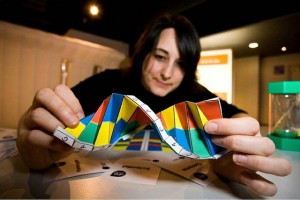When I was in 5th grade, my teacher gave us an assignment: design a quiz board. I’m sure you know the kind I’m talking about – a simple switchboard with a list of questions one side, answers on the other, and when you connect a question with the correct answer a little bulb lights up.
As an 11-year-old, I was crazy about this project. Wires! Chipboard! Lightbulbs! And all the poster paint a grade school heart could desire. I revelled in the freedom to craft my own quizz, but more than that, I was thrilled by the experience of creating my own electrical circuits. When a little light bulb gave a flickering glow for the first time, I was as excited as a cavewoman discovering fire.
Digital edge
I fondly think of this assignment as a precursor to the maker movement, and my teacher ahead of his time. This kind of constructive tinkering around with wires and pliers and circuits, whatever materials come to hand, is what the maker movement is all about, except that these days it’s got a digital edge. The hands-on approach of skills like woodwork is being fused with cutting-edge technological engineering, and a hefty dollop of roll-up-your-sleeves DIY ethic.
The maker movement is a subculture that has been enthusiastically embraced by adults, evident from the resounding success of Make magazine and spin-off Make Faires, held internationally. But kids are catching the maker bug too and making the movement their own, using Google hangouts to share projects and credit card-sized Raspberry Pis to develop their computer science skills. The maker movement allows kids’ creativity to explode and their wackiest ideas can become a reality. A fire-breathing mechanical dragon and an elaborate hamster hutch, designed as a stylish living room centerpiece, were among the diverse inventions created by kids at one Maker Faire.
Let kids’ inventive side flourish
Supporting kids with the space and resources to let their inventive sides flourish is of vital importance. Embracing the maker movement in our homes and schools allows kids to explore the possibilities of technology and engineering in a fun way and aids in the development important 21st century skills like creative thinking and innovation. Devices like 3D printers and laser cutters, which were once the preserve of industry professionals, are dropping in cost and becoming available for personal use, so that the possibilities of DIY today far outstrip anything previously possible.
However, you don’t have to have sophisticated tools like a 3D printer to embrace the ethos of the maker movement. Simple and inexpensive materials – like those needed to create a quiz board – still have powerful potential to ignite creativity. We should support kids to spark their innovation, whatever they’ve got to hand.
Are you a ‘maker’? How can we make our schools and homes into more effective ‘maker spaces’?
By Deirdre Kilbride
P.S. Teachers use Fishtree to plan lessons, find standard-aligned teaching resources, create assessments and see students performance, all in one place! If you’re a teacher, use Fishtree to prepare for your class and understand how well each student is learning. What’s more, it’s safe, secure, collaborative and easy! Try the next generation learning platform or contact us for a demo.
Image credits: Netduino + Nunchuck + Servos (aalmada) / CC BY 2.0
